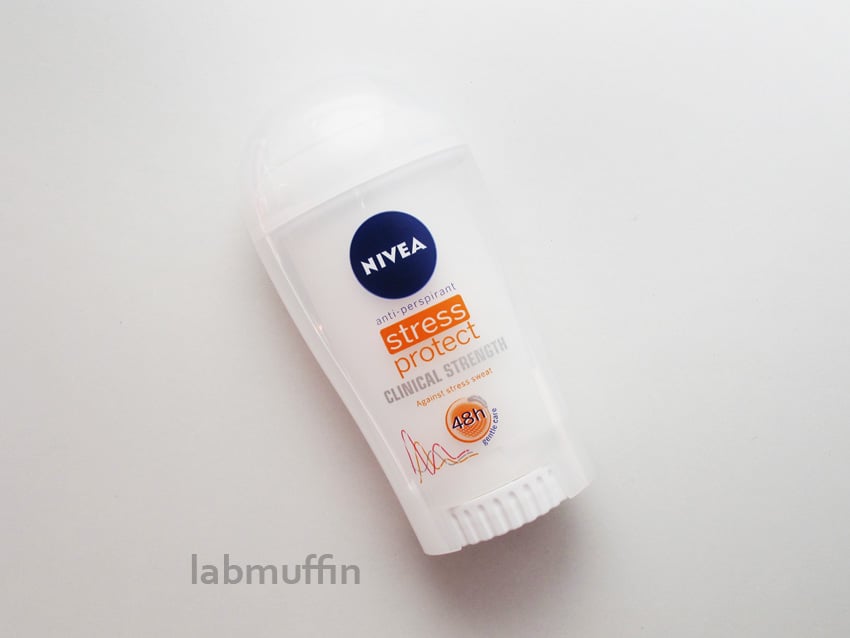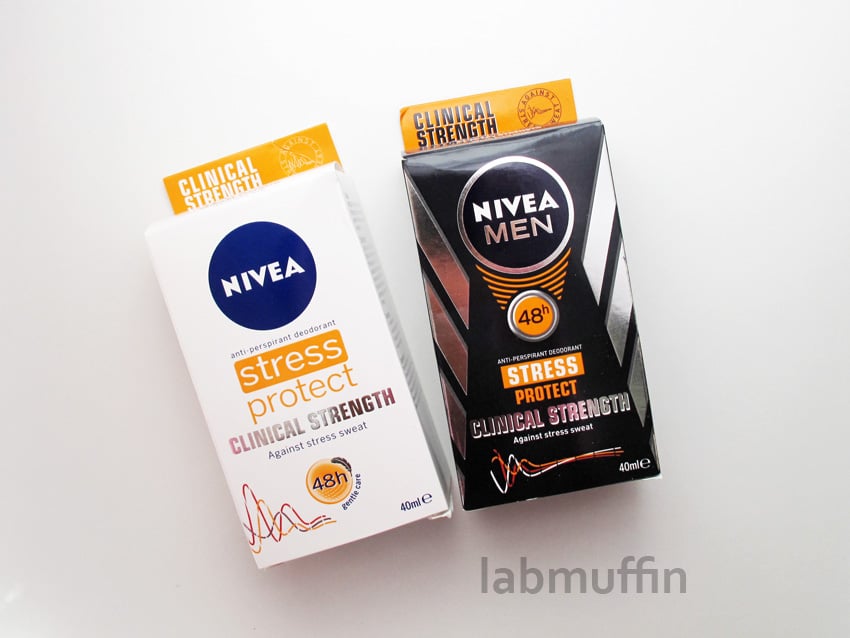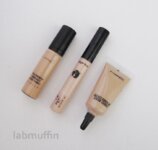My go-to antiperspirant deodorant, Nivea Stress Protect, has recently come out with a clinical strength version, and since it’s been a while since I blogged about underarm matters, I thought it was time to revisit the basics of sweat science…
What’s the difference between deodorant and antiperspirant?
Deodorant targets smell. It usually contains fragrance, and sometimes antibacterials too to kill the bacteria which feed on your sweat and create body odour. They won’t stop you from getting wet armpits though – that’s the job of antiperspirants, which stop perspiration (sweating). Antiperspirants are usually combined with deodorant.
How do antiperspirants work?
Antiperspirants contain aluminium salts. These react with small amounts of sweat to form a gel plug which blocks off the sweat gland. The plug comes out later as your skin cells shed.
There are two types of sweat: thermal sweat and stress sweating. Thermal sweat cools your body down when it’s hot or if you exercise, and is quite watery (99% water). It comes out of eccrine glands found all over your body. Stress sweat is sometimes called a “cold sweat” – it comes from adrenalin-fueled nervousness or anxiousness, and appears mainly in the armpits and groin from the apocrine glands. It contains less water and more proteins and lipids (about 20%), which bacteria feed off, and hence it tends to smell more (it’s mainly the bacteria that make body odour, not you!). Antiperspirants block off the armpit sweat, leading to less odour and less sweaty stains.
But isn’t that dangerous?
Luckily, no! The most common concerns are:
Overheating – You have sweat pores all over your body for cooling off. Underarms are only a small fraction, your body will still be able to stay cool!
Blocking waste from exiting the body – This would be a problem if sweat was a major route for waste disposal. However, it’s not – waste will not build up in your body if you block off your armpits! The tiny amount that would’ve come out that way will just be redirected elsewhere.
Breast cancer: It’s incredibly implausible that there’s a link between deodorants and breast cancer. There’s a great post on Science-Based Medicine that examines the claims with in-depth looks at the studies in question – it’s a very interesting read.
What’s the difference between clinical strength and regular?
Clinical strength antiperspirants contain the highest concentration of active ingredients allowed (around 20%). They also contain instructions to apply them at bedtime, when sweat is minimal, to allow the aluminium to form plugs in sweat pores overnight and block sweat, instead of being washed away by sweat gushing out. The plugs will last through a morning shower!
In the Nivea range, the clinical strength antiperspirant actually uses aluminium zirocnium tetrachlorohydrex glycine instead of the aluminium chlorohydrate that’s used in the regular version. This is a newer generation form of aluminium that’s less irritating to the skin, which means less acne and stinging.
Like the regular versions, Nivea Stress Protect Clinical Strength comes in a men’s and a women’s scent. Both scents are quite subtle. Unlike the regular roll-on, the Clinical Strength versions are housed in a lighter plastic container, and come as a solid stick, which I find much easier to use. Like the regular versions, these contain antibacterial zinc citrate and moisturising avocado oil as well as the aluminium-based antiperspirant chemicals.
Nivea Stress Protect Clinical Strength Anti-Perspirant Deodorant retails for $14.75 for 40 mL and is on shelves now.
This product was provided for editorial consideration, which did not affect my opinion. For more information, see Disclosure Policy.








Fantastic post! I’ve never heard any claims that there may be a link between breast cancer and deodorant, so I’ll give that link a read, sounds interesting. I struggled to find an antiperspirant that actually worked for me for so long, the Rexona and Dove versions of this one have been my saviors 🙂
Very informative post! I’ve never really known how antiperspirants work, but now I do haha! I’ll definitely be more educated when I go out to repurchase a deodorant.
Tasha // shiwashiful.
I have very sensitive skin, especially in my armpit area, and find that deodorants that contain aluminium salts, denatured alcohol or even stuff like zinc tend to really irritate my armpits. Like, ten minutes after I’ve applied an antiperspirant, it would get really start to heat up and sting and feel really itchy, and results in hyperpigmentation of my armpit area. I would really love to know if you’ve tried any natural deodorants, and which one would you recommend? Love your blog by the way!
Thank you! I haven’t tried any yet unfortunately or fortunately – I have that Asian gene where I don’t get much underarm odour, so I only really use antiperspirant and only aluminium salts really do that…
This was highly educational! As always. 🙂
I would like to know as well if the aluminum is absorbed ( I read somewhere that 0,012% is absorbed?), if it accumulates in the body and if there’s a link with Alzheimer.
And also, the same regarding potassium alum. Some way it’s too big to be absorbed, but then in water it turns into ions and ions can be absorbed, but wait they’re negative ions and those are not absorbed. Confusing, ugh.
What sellers say is that it doesn’t form plugs, but only kills bacteria. Is that true?
Maybe food for another blogpost? 🙂